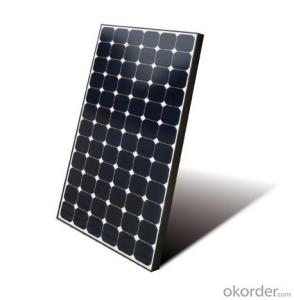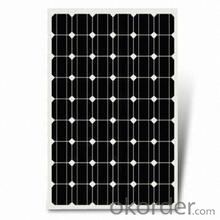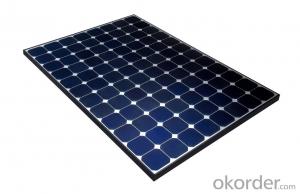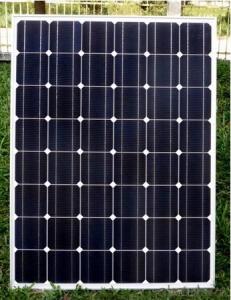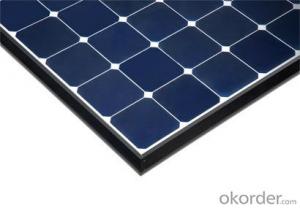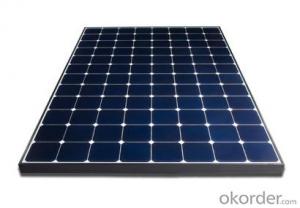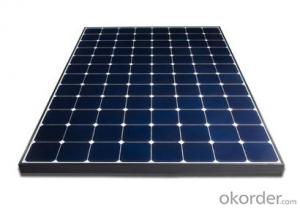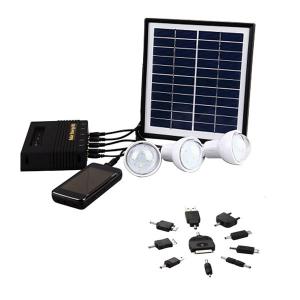Solar Energy Systems Canada - CNBM On Grid System 900W with Certificate UL TUV CE
- Loading Port:
- Shanghai
- Payment Terms:
- TT OR LC
- Min Order Qty:
- 100 watt
- Supply Capability:
- 1000 watt/month
OKorder Service Pledge
OKorder Financial Service
You Might Also Like
Specification
CNBM On Grid System 900W with Certificate UL TUV CE
Product description
A grid-connected photovoltaic power system, or grid-connected PV system is anelectricity generating solar PV system that is connected to the utility grid. A grid-connected PV system consists of solar panels, one or several inverters, a power conditioning unit and grid connection equipment. They range from small residential and commercial rooftop systems to large utility-scale solar power stations. Unlike stand-alone power systems, a grid-connected system rarely includes an integrated battery solution, as they are still very expensive. When conditions are right, the grid-connected PV system supplies the excess power, beyond consumption by the connected load, to the utility grid.
Connection of the photovoltaic power system can be done only through an interconnection agreement between the consumer and the utility company. The agreement details the various safety standards to be followed during the connection.[4]
Grid-connected PV can cause issues with voltage regulation. The traditional grid operates under the assumption of one-way, or radial, flow. But electricity injected into the grid increases voltage, and can drive levels outside the acceptable bandwidth of ±5%.[8]
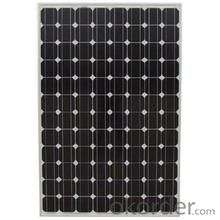
Application
Industrial
Commercial
Residential
Feature
Residential, grid-connected rooftop systems which have a capacity more than 10 kilowatts can meet the load of most consumers.[2] They can feed excess power to the grid where it is consumed by other users. The feedback is done through a meter to monitor power transferred. Photovoltaic wattage may be less than average consumption, in which case the consumer will continue to purchase grid energy, but a lesser amount than previously. If photovoltaic wattage substantially exceeds average consumption, the energy produced by the panels will be much in excess of the demand. In this case, the excess power can yield revenue by selling it to the grid. Depending on their agreement with their local grid energy company, the consumer only needs to pay the cost of electricity consumed less the value of electricity generated. This will be a negative number if more electricity is generated than consumed.[3] Additionally, in some cases, cash incentives are paid from the grid operator to the consumer.
Packaging
With carton and box
- Q: How does the quality of solar panels vary across different manufacturers?
- The quality of solar panels can vary significantly across different manufacturers due to variations in materials, manufacturing processes, and quality control measures. Some manufacturers may use higher-quality materials and advanced technologies, resulting in more efficient and reliable solar panels. Additionally, reputable manufacturers often invest in rigorous testing and certification procedures to ensure the durability and performance of their products. On the other hand, lower-quality manufacturers may cut corners in production, leading to less efficient panels with shorter lifespans. Therefore, it is crucial to research and choose solar panels from reputable manufacturers with a proven track record of delivering high-quality and reliable products.
- Q: What are the different types of solar energy systems?
- There are primarily three types of solar energy systems: solar thermal systems, photovoltaic (PV) systems, and concentrated solar power (CSP) systems. Solar thermal systems use sunlight to heat water or air for various applications such as heating homes or generating electricity. PV systems directly convert sunlight into electrical energy using solar panels, which can be used to power homes or businesses. CSP systems use mirrors or lenses to concentrate sunlight onto a receiver, which produces heat that can be used to generate electricity.
- Q: Can solar energy systems be used for powering space exploration missions?
- Yes, solar energy systems can be used for powering space exploration missions. Solar panels are commonly used in space missions to generate electricity by converting sunlight into usable energy. These panels are lightweight, reliable, and can provide a continuous power source in space, making them ideal for long-duration missions. Additionally, solar energy is abundant in space and can be harnessed even in the most remote locations, reducing the need for heavy and limited fuel supplies.
- Q: Can solar energy systems be used in areas with limited access to solar energy permits and approvals?
- Yes, solar energy systems can still be used in areas with limited access to solar energy permits and approvals. In such cases, off-grid solar systems can be installed, allowing individuals or communities to generate and use solar energy without relying on local utility permits. These systems typically involve smaller-scale installations and can be a viable option for areas with limited access to solar energy permits and approvals.
- Q: What is the difference between a microinverter and a string inverter in a solar energy system?
- A microinverter is a small inverter that is typically installed on each individual solar panel in a solar energy system. It converts the DC (direct current) electricity generated by the panel into AC (alternating current) electricity, which is used to power household appliances or fed back into the grid. On the other hand, a string inverter is a larger inverter that is installed at a central location and connected to multiple solar panels in a string configuration. It converts the combined DC electricity from the string of panels into AC electricity. The main difference between the two is that microinverters allow for individual panel optimization, meaning that if one panel is shaded or not performing well, it does not affect the performance of the other panels. In contrast, a string inverter's performance is limited by the weakest panel in the string. Additionally, microinverters offer better monitoring capabilities as they can provide real-time data on the performance of each individual panel, while string inverters provide overall system-level monitoring.
- Q: Can solar energy systems be financed or leased?
- Yes, solar energy systems can be financed or leased. Many companies and financial institutions offer financing options to make solar energy systems more affordable for homeowners and businesses. Leasing is another popular option where the solar panels are owned and maintained by a third-party company, allowing customers to benefit from the energy generated without the upfront costs of purchasing the system.
- Q: Can solar energy systems be used for powering outdoor lighting?
- Yes, solar energy systems can be used effectively for powering outdoor lighting. Solar-powered outdoor lighting systems are designed to capture sunlight during the day and convert it into electricity, which is stored in batteries. This stored energy is then used to power the outdoor lights during the night, making them energy-efficient and environmentally friendly. Additionally, solar-powered outdoor lighting systems do not require extensive wiring or electrical connections, making them easy to install and maintain.
- Q: Can solar energy systems be used in powering amusement parks?
- Yes, solar energy systems can definitely be used in powering amusement parks. Solar power has become increasingly popular in recent years due to its numerous benefits. Amusement parks require a significant amount of energy to operate rides, lighting, and other facilities. By utilizing solar energy systems, parks can reduce their reliance on traditional energy sources and significantly lower their operational costs. Solar panels can be installed on rooftops, parking lots, or open areas within the amusement park to harness the power of the sun. These panels convert sunlight into electricity, which can be used directly to power various park operations. Additionally, excess energy generated during peak sunlight hours can be stored in batteries for use during cloudy or nighttime periods. The advantages of using solar energy in amusement parks are manifold. Firstly, it is a renewable and sustainable energy source, meaning it does not deplete natural resources or produce harmful emissions. This makes solar energy an environmentally friendly choice, aligning with the growing emphasis on green initiatives and reducing carbon footprints. Furthermore, solar energy systems can provide a stable and predictable source of power. Amusement parks often experience high peak energy demands during busy periods, such as weekends or holidays. Solar panels can easily handle these fluctuations and ensure a reliable power supply, reducing the risk of power outages or disruptions. Moreover, installing solar panels can enhance the overall image and brand of an amusement park. By demonstrating a commitment to sustainable practices, parks can attract environmentally conscious visitors and differentiate themselves from competitors. This can contribute to a positive public image and potentially increase visitor numbers. In conclusion, solar energy systems can undoubtedly be used to power amusement parks. Their ability to generate clean, reliable, and cost-effective electricity makes them an ideal solution for powering the energy-intensive operations of amusement parks. By harnessing the power of the sun, parks can reduce their carbon footprint, lower operational costs, and enhance their overall appeal to visitors.
- Q: Can solar energy systems be used for powering hospitals?
- Yes, solar energy systems can be used for powering hospitals. Solar panels can generate electricity to meet the energy needs of hospitals, reducing reliance on fossil fuels and lowering operating costs. Additionally, solar energy systems can provide a reliable and uninterrupted power supply, especially in remote areas or during power outages, ensuring continuous operation of critical medical equipment and enhancing healthcare services.
- Q: Can solar energy systems be used in agricultural settings?
- Yes, solar energy systems can definitely be used in agricultural settings. In fact, the use of solar energy in agriculture has been gaining popularity in recent years. Solar panels can be installed on rooftops or as ground-mounted systems in agricultural fields to generate clean and renewable electricity. There are several ways in which solar energy can be utilized in agricultural settings. One common application is to power irrigation systems. Solar-powered water pumps can efficiently draw water from wells or other water sources and distribute it for irrigation purposes. This helps farmers reduce their dependence on fossil fuel-powered pumps and lowers their overall energy costs. Solar energy can also be used to power electric fences, lighting systems, and ventilation systems in livestock operations. These systems help improve the conditions for animals, enhance productivity, and reduce the environmental impact of traditional energy sources. Additionally, solar energy can be utilized for crop drying and processing. Solar dryers can be used to remove moisture from crops, reducing the risk of spoilage and improving their shelf life. Solar-powered processing equipment, such as grain mills and oil presses, can also be employed to enhance the efficiency and sustainability of agricultural operations. Moreover, solar energy systems can provide a reliable source of electricity to remote agricultural areas that are not connected to the grid. This enables farmers to access modern technologies and improve their productivity and income. Overall, the integration of solar energy systems in agricultural settings offers numerous benefits. It reduces greenhouse gas emissions, decreases reliance on fossil fuels, lowers energy costs, improves efficiency, and enhances the sustainability of agricultural practices. Therefore, solar energy is a viable and promising option for powering various agricultural activities.
Send your message to us
Solar Energy Systems Canada - CNBM On Grid System 900W with Certificate UL TUV CE
- Loading Port:
- Shanghai
- Payment Terms:
- TT OR LC
- Min Order Qty:
- 100 watt
- Supply Capability:
- 1000 watt/month
OKorder Service Pledge
OKorder Financial Service
Similar products
Hot products
Hot Searches
Related keywords
